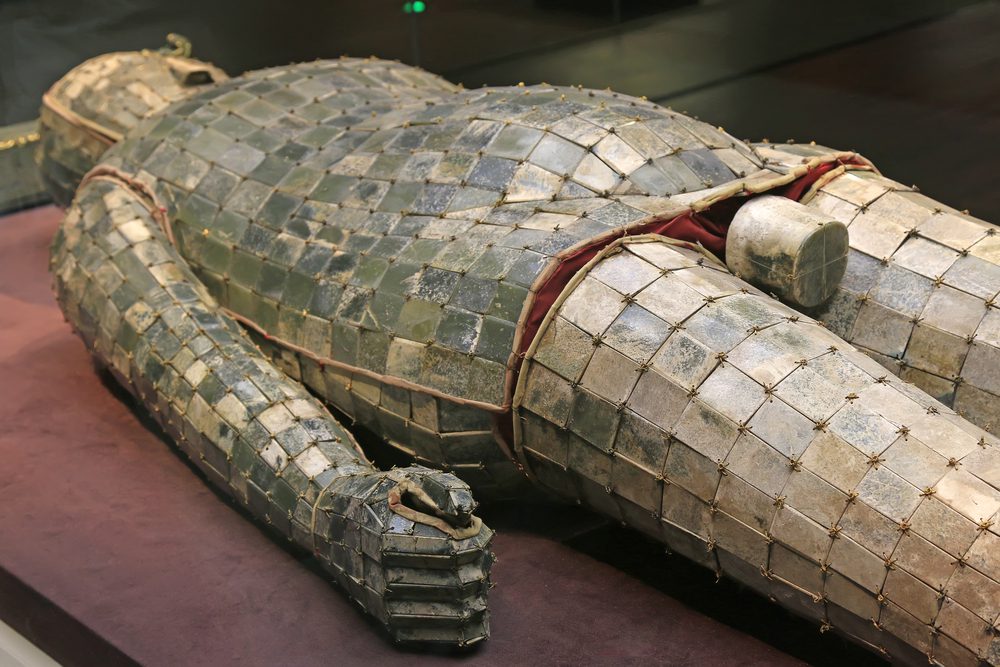They are possibly the most magnificent burial suits in history. Two thousand years ago, during the Han Dynasty, ancient Chinese royals were buried in suits of armor made from hand-crafted pieces of jade. These intricately cut pieces were then fastened together using gold and silver thread. It was a practice reserved only for the wealthiest and most politically important individuals at the time. So, why did they do it?
The power of jade in death
Jade (nephrite) has a prominent place in ancient Chinese history. The stone was prized for its durability and strength from as early as the Neolithic period (around 3500-2000 BCE) where it was used for tools and weapons. Over the centuries, the stone also became increasingly cherished for its assumed magical properties, which led it to also be fashioned into various ceremonial and ornamental objects, as well as exquisite jewelry. By the time the Han Dynasty emerged (from 202 BCE), jade objects were more frequently fashioned into animal motifs and as decorative objects for the elite.
Due to its durability and aesthetic qualities (especially its translucent color), jade became a symbol of purity, moral integrity, and immortality. For the Han, a person had two parts to their soul. One part, the spirit-soul (hun 魂) traveled to the afterlife upon death, where it settled in the paradise of the immortals (xian). The other part, the body-spirit, remained on earth in the grave and could only be reunited with its counterpart through ceremonial rites. Jade was an important part of this practice, as its mystical properties were through to help preserve the body as well as the soul that was attached to it in the grave.
This association with the soul and longevity is most clearly articulated in the text by the Chinese historian Sima Qian (145-86 BCE) who described Emperor Wu of Han (157-87 BCE) as having a jade cup inscribed with the words “Long Life to the Lord of Men”. The emperor was also known to take an elixir made from powdered jade mixed with morning dew collected on a 6-meter (20-foot) bronze plate in an attempt to prolong his life – spoiler, it did not work.
Nevertheless, given jade’s significance for the soul, it makes sense that the Han would use as much of it as possible for their special dead. The practice of making full-body suits of jade to safeguard the body’s immortality is the next logical step.
Every part of the anatomy was protected in death, apparently. Image credit: junrong/Shutterstock
Jade suits – a legend made real
Jade suits have been “known” about for a long time. They were first documented in Chinese literature around 320 CE, but they were assumed to be a myth until the late 20th century. Then, in 1968, two complete jade suits were discovered which were made from thousands of small plates of solid jade fastened together using gold wires.
The suits were discovered in the tomb of Han Dynasty ruler Liu Sheng and Princess Dou Wan, his wife. Until this point, the tomb had remained undisturbed but its contents have become known as some of the most important archaeological discoveries of the 20th century.
Since these first discoveries, more have been unearthed to show they were actually quite common among the aristocracy of the Han Dynasty.
According to the Book of Later Han (Hòu Hànshū), the type of thread used in the suits depended on the person’s status. Not everyone was allowed to have golden-threaded jade. Emperors were allowed it, whereas princes, princesses, dukes, and marquises used silver thread. Sons and daughters of these aristocrats were allowed copper thread and lesser nobles were given silk. Everyone below this social level was forbidden such special suits for their graves.
The practice appears to have ended in the reign of the first emperor of the state of Wei, during the Three Kingdoms period (200-280 CE). The fear was that such luxurious goods would attract grave robbers who would burn the suits to get at the gold and silver that held them together.
Source Link: Jade Burial Suits – Why The Ancient Chinese Lay Their Dead To Rest In Such Opulence
